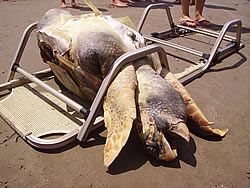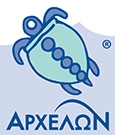New IUCN Red List Assessment of the Loggerhead Sea Turtle Caretta caretta in the Mediterranean: long term protection pays off

To avoid any misinterpretations that may rise from this shift, the new listing has to be further explained. According to the new IUCN criteria the listing of species is now based on their “imminent extinction risk”. So, the species assigned to the “LC-Least Concern” category are not necessarily safer nor does it mean that their protection must stop but that “they are not in danger of extinction in the near future on the condition that their current status remains the same”. Specifically, the IUCN definition states: “The category Least Concern is applied to taxa that do not qualify (and are not close to qualifying) as threatened or Near Threatened. It is important to emphasize that "least concern" simply means that, in terms of extinction risk, these species are of lesser concern than species in other threat categories. It does not imply that these species are of no conservation concern.”
It must be noted that the IUCN listing based on the new criteria has comparative value among the species. This means that a long lived species such as the loggerhead turtle, with many nesting beaches in the Mediterranean, some of which presenting significant increases in nest numbers due to long term protection measures, as it happens in Kyparissia Bay, cannot be considered endangered as opposed to other species with restricted geographic distribution, very small populations or populations in sharp decline. We must also take into account that the new IUCN listing does not describe the threats that a species has to deal with, nor the full status of its population, nor the need of protection measures. It rather focuses on the species prospects of survival in the near future examining mainly its geographical range and population trends.
Thus, the new listing of Caretta caretta in the Mediterranean actually reflects the success of long term conservation measures which must continue on by international organizations, international treaties, the European Union, governments, local communities and environmental organizations. The IUCN’s Marine Turtle Specialist Group in their statement (see attached file) specifies that this listing is a result of the relatively good condition of the Loggerhead Turtle in the Mediterranean thanks to all the important conservation actions that take place all these years. They further mention that the Mediterranean population must be considered as “conservation dependent” and “any decrease of the current conservation effort would very likely be detrimental”. Finally, they clarify that the loggerhead populations in the Mediterranean should continue to be monitored and further studied as updated and reliable data would be needed for the next assessment. The full statement of the IUCN’s Marine Turtle Specialist Group follows (for the original statement click here).
A new IUCN Red List Assessment of the loggerhead sea turtle (Caretta caretta) is now available online.
The assessment was completed by the Marine Turtle Specialist Group of the IUCN Species Survival Commission, a global network of sea turtle experts. This is the second sea turtle species (after the leatherback turtle, Dermochelys coriacea) that has been assessed at both the global and subpopulation levels using IUCN Red List Criteria. Red List assessments at the subpopulation level are much more meaningful for conservation planning than those done solely at the global scale, especially for wide-ranging species like sea turtles.
Globally, the loggerhead turtle is now listed as Vulnerable. The 10 loggerhead subpopulations have been assigned to categories ranging from “Critically Endangered” to “Least Concern,” representing in most cases a change from the “Endangered” category to which the species as a whole was assigned in the previous assessment from 1996. Given the increasing use of the IUCN Red List to inform conservation priorities in a variety of contexts, we want to clarify some aspects of the Red List in order to avoid misinterpretations about the status of those loggerhead subpopulations that are now listed as “Near Threatened” or “Least Concern.”
The IUCN Red List Categories and Criteria represent one approach for assessing and comparing the conservation status of very different species, with a specific aim to identify species and subpopulations facing imminent or high risk of extinction globally based on past, current, and expected future conditions and anthropogenic factors.
Loggerhead subpopulations that have been newly listed in the categories “Near Threatened” or “Least Concern” indicate that those subpopulations are not at imminent/high risk of extinction. However, this evaluation is based on their present situation, which takes into account the results of past conservation efforts, many of which have been in place for decades. In this respect, the current status of these subpopulations represents a measure of the success of past conservation efforts. For this reason, these subpopulations need to be considered to be conservation-dependent. Any decrease of the current conservation effort would very likely be detrimental. Indeed, it is only because of such prolonged conservation efforts that some loggerhead subpopulations are now being categorized as “Near Threatened” and “Least Concern” rather than higher categories of threat like “Vulnerable,” “Endangered,” and “Critically Endangered.” Moreover, within a subpopulation categorized as “Least Concern” or “Near Threatened” there may still be sea turtle stocks that are facing a high risk of extinction at a national or local level.
Red List assessments are updated regularly to reflect the most current and best available data, and as such the Red List status of loggerheads may change with time. All the loggerhead subpopulations must be monitored and studied further in order to assure that conservation strategies and interventions are adjusted to respond to possible future changes. Red List assessments are policy relevant rather than policy prescriptive, and to derive adequate policies at regional or national levels may require many different types of assessments.
Based on the present state of knowledge, all loggerhead subpopulations are in need of intensive conservation measures to improve or to maintain their current conservation status.
Joanne, whatʼs new at the Rescue Centre (December 2015)?
The scientific work of ARCHELON
RECENT NEWS
- OUR NEWS12/12/2025
The Power Behind Sea Turtle Conservation: Our 2025 Field Leaders
With deep gratitude, we honor all the Field Leaders who contributed to the success of the 2025 Field Projects.
- OUR NEWS10/12/2025
Unprecedented appearance of Leatherback Turtle on a Mediterranean beach
A new scientific record brings to light an extremely rare event for the marine life of the Mediterranean: the first confirmed appearance of an adult Leatherback Turtle (Dermochelys coriacea) attempting to nest in the Mediterranean basin.
- OUR NEWS08/12/2025
Applications Now Open for 2026 ARCHELON Field Leaders Posts!
ARCHELON is pleased to announce that applications are now open for the 2026 Field Leader positions across all nesting projects (applications open until January 31st).
- OUR NEWS05/12/2025
Saving Sea Turtles Together – A Tribute to Volunteers
On Volunteer Day, we take a moment to celebrate all those who came from near and far, put on the blue T-shirt, and embraced this important responsibility.
- OUR NEWS01/12/2025
Laganas Bay, Zakynthos: Successful Loggerhead Reproduction, Ongoing Habitat Problems
On the beaches of the Zakynthos National Marine Park, around 2,155 turtle nests successfully hatched thanks to active protection measures, but human pressures on coastal and marine habitats continue.
- OUR NEWS26/11/2025
A Second Chance: Two Loggerhead Sea Turtles Return to the Sea Thanks to Dedicated Rescues
This summer, two adult loggerhead sea turtles, ‘Aktaia’ and ‘Herbert’, arrived at ARCHELON’s Sea Turtle Rescue Centre needing urgent help after sustaining severe head injuries.
- OUR NEWS11/11/2025
Volunteering Projects 2026: Sea Turtles Need You, the Planet Needs Us!
ARCHELON welcomes volunteers from all over the world and of all ages (over 18) and no prior experience is required! If you speak English, are at least 18 years old, and are in good physical condition, you can do this!
- OUR NEWS10/11/2025
Outstanding Recognition for ARCHELON at the Effective Dialogue Conference 2025
On Thursday, November 6, 2025, ARCHELON received an honorary distinction for its substantial contribution to effective dialogue on sustainability, social responsibility, and the environment
- OUR NEWS06/11/2025
6th Year of Online Tours: The sea turtles are traveling across Greece once again!
Students from every corner of the country, as well as from international schools, have the opportunity to learn up close about the lives of the turtles cared for at the Sea Turtle Rescue Centre in Glyfada, Attica, and to discover how rescue efforts impact the marine world.
- OUR NEWS31/10/2025
The lecture turned into reality: A real turtle rescue for the students from Kallithea!
The students spotted a sea turtle floating in the water right after their educational tour of the ARCHELON Rescue Centre and immediately notified the rescuers.
- OUR NEWS24/10/2025
LIFE MareNatura Documentary Premier
From seabird monitoring and genetic sampling, to unique underwater footage of marine mammals, the testimonies of scientists bring to life the hidden stories of the sea.
- OUR NEWS23/10/2025
ARCHELON participates in the "Science Festival 2025 – The Voice of the Ocean"
The French Institute of Greece is organizing a celebration from 10 to 27 November 2025 dedicated to science and the ocean! World premiere of the LIFE MareNatura documentary on November 13th.
- OUR NEWS22/10/2025
Kyparissia Bay: ARCHELON Records 6,100 Nests and Calls on the State to Immediately Implement the National Action Plan for the Loggerhead
In 2025 approximately 6,100 nests were recorded, marking a 74% increase compared to the average of the previous 12 years!
- OUR NEWS10/10/2025
We bid farewell to a devoted environmentalist and friend, Yiannis Roussopoulos.
- OUR NEWS02/10/2025
Jane Goodall’s words still warm our hearts
Thank you, Dr. Goodall, for all that you have taught us and for the life example you have left behind.


